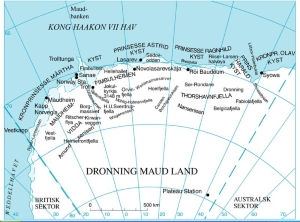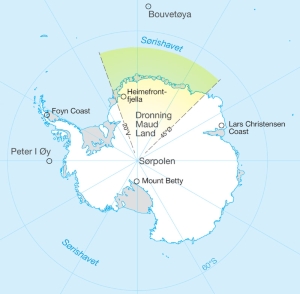Did you know that the term Antarctic actually comes from “anti-Arctic”?
The name Arctic comes from the Greek word Arktos, which means bear. The bears in question are not polar, but celestial: the Great and the Little Bear, constellations visible only in the Northern Hemisphere. Antarktikos – Antarctica – is thus the opposite of “the land of the bear” and is situated on the other side of the planet.
 Dronning Maud Land, Antarctica. Map: Norwegian Polar Institute
Dronning Maud Land, Antarctica. Map: Norwegian Polar Institute
 Dronning Maud Land, Antarctica. Map: Norwegian Polar Institute
Dronning Maud Land, Antarctica. Map: Norwegian Polar Institute
The Antarctic continent was discovered early in the 19th Century. But many decades passed before the entire coast of the continent had been explored, and Norwegians were among the first to lay eyes on Antarctic shorelines. The oldest Norwegian place names in Antarctica designate places along the Antarctic Peninsula; the whaler Jason and her crew passed through these waters in 1893 and left behind the names Foyn Coast and Mount Jason. Many Norwegian place names can also be found in areas visited by Roald Amundsen and his companions in 1911 on their way from Framheim to the South Pole. Everyone who sailed with Fram had one of the nearby mountaintops named after him. Amundsen also honoured several other people by naming geographical features after them. An example is Mount Betty, which Amundsen named after the beloved nanny who had cared for him in his childhood.
In the 1920s and 1930s, several Norwegian research expeditions were sent to Antarctica with funding from the whaling industry, and both boats and aircraft were used to explore and chart the continent’s coastlines. Several of the place names along the coast of the area we now call Dronning Maud Land were established during these expeditions. Many of these places bear names inspired by the royal family of that time. Farther east, in what is now the Australian sector, is the Lars Christensen Coast. This area is named after the shipping magnate who financed the Norwegian mapping expeditions. Norway annexed Dronning Maud Land in January 1939. After the Second World War, a mountain range some distance inland was named Heimefrontfjella (the Home Front Mountains) in honour of the Norwegian resistance movement. Many features in the terrain of this area were named after partisan groups and heroes from the resistance during the war.
Today, the responsibility for Norwegian place names in Norwegian territories in Antarctica rests with the naming committee of the Norwegian Polar Institute. Place names in Norwegian polar areas consistently follow the conventions of “New Norwegian”, one of Norway’s two official language forms. But there are not only Norwegian place names in Dronning Maud Land. Several other nations have done mapping and naming in this part of Antarctica. For this reason, we also find German and Japanese names on the maps. In 1974, Norwegian and British naming committees entered into an agreement stating that they would respect each others’ place names in their respective sectors. All British maps of Antarctica will therefore show the place names in Dronning Maud Land in Norwegian. Likewise, all maps produced by the Norwegian Polar Institute will give English names within the British sector.